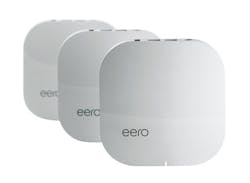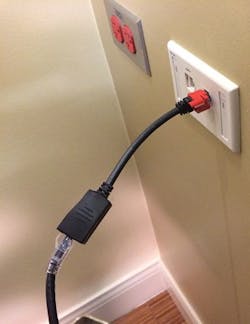Editor's Picks
Colorado school district deploys full PSIM system via 3xLogic’s security cameras, hybrid NVRs
3xLOGIC, Inc., a provider of integrated intelligent security solutions, announced that Littleton Public Schools (LPS), in Colorado, continue to roll out new cameras and 3xLOGIC hybrid NVRs as they move toward their ambitious goal of creating a district-wide, comprehensive physical security information management (PSIM) system. Upon completion, the new system will oversee and coordinate security for approximately 15,000 students and staff at LPS’s 28 school and administrative buildings.
“Our overall goal is pretty simple,” said Guy Grace, LPS director of security and emergency preparedness. “We must have quality technology delivering quality results, because we cannot have a successful educational experience without safety and security taken care of, and taken care of well.” In late 2012, Grace said he came to an important conclusion: “I was so frustrated with our DVRs that we’d been installing since the last bond issue approval. At first, they were meeting our needs, they could handle the PTZ cameras and motion detection, but over time the supplier started eliminating basic functions we needed. It was making our jobs harder than they needed to be.”
Around this time, Grace said he was introduced to 3xLOGIC at a tradeshow. “I found out the company was local and was doing real good things. I decided to learn more.” A few months later, LPS had another bond referendum. “We selected 3xLOGIC as a vendor for that bond issue, and in early 2013, we began purchasing NVRs and cameras. What I really liked was the hybrid NVR allowed me to incorporate existing analog cameras and add new IP cameras whenever I wanted. This is a life saver, because I can eliminate older tech and migrate to IP at my pace. This also allows us to have compatibility across all our schools, and that’s crucial.”
In December 2013, LPS suffered a fatal shooting at their Arapahoe High School. “The shooting caused us to expedite everything and 3xLOGIC responded well to our sped-up timeline. Now, we have a darn good system over at Arapahoe High School.” After the initial installation projects, LPS adopted 3xLOGIC NVRs at other school locations. As DVRs failed, they replaced them with 3xLOGIC. After another recent bond issue provided him with more budget, Grace moved to convert nine more schools to PoE. “I’ve got 29 miles between all of our buildings, so the cameras are our extra eyes,” he added. “If you don’t have those extra eyes, you’ll have to count on luck to see all the things you’ve got to be able to control. All I can say is it’s been very positive from the get-go.”
Once the entire project is fully completed LPS will have a total 1400 cameras, of which 780 are now installed. Grace expects the mix to be about one-third IP and two-thirds analog initially-demonstrating how vital the hybrid feature of the 3xLOGIC NVR is-and a full migration to HD IP camera sometime in 2017. Also, as the project has progressed, LPS has been increasing the proportion of 3xLOGIC cameras in the overall mix. “3xLOGIC cameras are very easy to install, and because the LPS staff does a lot of the installation work, that’s very important to us,” said Grace.
“A full-fledged PSIM system is our end goal,” he continued. “We can bring a variety of systems that are non-proprietary-access control, VMS, fire detection, perimeter, mass notification, barrier protection/detection, and diagnostic systems-all together into one unified system. Technology has my back.” Under Grace, there are 10 security officers. During the day, there are two technicians on duty with one security officer and Grace. “A PSIM allows us the flexibility to grow and expand, if needed we can have four operators at any one time in our control room,” he added. “We have the flexibility to bring in people to deal with what is happening, what is needed. My staff needs to liaise with 145 users of the system across our entire district. We have to manage this system as efficiently as possible, so we train our people to wear multiple hats. It seems to be working, we have not had any staff turnover since 2010.”
A total of 145 people have access to the video footage-secretaries, administrators and others will be using the complete digital system. At present, LPS is issuing those 145 users tablets with 3xLOGIC Android software to enable mobility and faster, more accurate responses. LPS is providing designated security and police vehicles with video feeds as well.
“Every day there is something we use the video for, we should write a book,” concludes Grace. “I’ve been in this business for 26 years. Back in the day we’d have a burglary a week, now they’re few and far between. We do have several incidents a day-student discipline issues, vandalism, suspicious incidents … but this system is a huge deterrent and it’s helping keep our school community safe. Video surveillance is probably one of the best tools in our security system. With proper camera placement and video quality, we’ve brought vandalism down 75-percent-plus. Under our old system, we saw vandalism rates creeping back up. The ease of use and the compliments we get have been a big improvement. That’s huge. You want it to be a positive experience so that people will use it. If we’re using it, then we’re successfully improving security on our campuses.” t
Home WiFi system based on wireless mesh networking secures $50 million in funding
Home WiFi system developer eero inc. announced it has secured a $50 million round of growth funding led by Menlo Ventures with significant participation by Index Ventures. eero says its system technology “blankets customers’ homes in fast, reliable WiFi. Instead of a single router, eero uses multiple access points placed throughout the home to create a wireless mesh network that covers every corner of every room. The eero system is simple to set up and easy to manage using the eero app, and over-the-air software updates give customers new features, performance improvements, and constantly improving security.”
The new funders join eero’s existing investors, First Round Capital, Shasta Ventures, Redpoint Ventures, Playground Global, and others, which also participated in the round, bringing the company’s total funding to over $90 million. The funding will be used to expand distribution, provide customer support, and grow the eero team. The company’s products will also be available for the first time at a brick and mortar retailer, launching in over 500 Best Buy stores in the U.S. this summer, and on BestBuy.com.
“Since we started shipping eero systems to customers earlier this year, we have been building on our momentum, scaling our infrastructure, and improving our software so we can support our growing customer base,” said Nick Weaver, eero founder and chief executive officer. “With this round of funding from leading investors, eero is well-positioned to provide a strong foundation for the connected home on an even larger scale.” t
Premium certified HDMI cabling now available, ensures feature-rich 4K/UltraHD content delivery
Universal Electronics Inc., a specialist in universal control and sensing technologies for smart homes, announced that its full line of HDMI cables has been certified by the Premium HDMI Cable Certification Program. The new testing and certification program ensures consumers using Universal Electronics’ HDMI cables to connect the latest 4K/UltraHD equipment can enjoy the full potential and feature-rich content of the 4K/UltraHD experience.
“There’s a ton of confusion out there concerning HDMI cables and which ones are the best in delivering the 4K/UltraHD features. The last thing people want is a cable that under-performs and results in service calls, returns, or unhappy customers,” said Lou Hughes, executive vice president, Americas, for Universal Electronics. “With the new Premium HDMI Cable Certification, consumers can have absolute peace-of-mind knowing that our cables will provide the highest quality and speeds to reliably deliver 4K content.”
The Premium HDMI Cable Certification Program is a new program designed to give end users confidence when purchasing new HDMI cables for their 4K/UltraHD products. Through the program, HDMI cables are rigorously tested to ensure they can reliably support the full 18 Gbps bandwidth and delivery of features enabled by the most recent HDMI specification including advanced video formats such as 4K @ 60Hz, wide color gamut and High Dynamic Range (HDR). The program also incorporates new testing guidelines for EMI levels to minimize unwanted interference with wireless signals.
These tests can only be performed by HDMI Authorized Test Centers (ATCs) that have access to the HDMI specifications, test specs and authorized test equipment. Once testing is complete, the ATCs communicate directly with HDMI Licensing, LLC to certify test results and verify authorized adopters.
“It’s critical that all components in a 4K/UltraHD HDMI-enabled system are fully capable of delivering the high-bandwidth dependent features customers expect from their products,” said Brad Bramy, HDMI Licensing, LLC marketing director. “The launch of Universal Electronics’ new Premium High Speed HDMI Cables ensures its cables are ready for today’s new 4K/UltraHD products and content, and installations will be future-proof for when customers add new upgraded products.” t
Panduit unveils Cat 6a/6/5e break-away adapter
Panduit has introduced a new adapter designed to release under force to eliminate tripping hazards, protect expensive equipment, and prevent damage to network infrastructure in medical, education and commercial applications.
The Panduit Break-Away Adapter attaches to a standard copper patch cord, and then plugs into either a piece of equipment or an RJ45 outlet. When pulling force is applied-such as when a medical cart is rolled away from the wall in a hospital room-the adapter releases. This prevents equipment being pulled off carts or tables, or jacks being pulled out of the wall, and prevents costly damage.
Developed for Category 6A performance, the breakaway adapter is backward-compatible to also work with Category 6 and 5e channels. t
Fiber distribution frame holds 4032 LC fibers
The newest optical fiber distribution frame from trans data elektronik (tde) “ensures highest packing density within the smallest space,” the company said when announcing the frame. “Up to 4032 fibers can be terminated with LC connectors on 46 height units. The patented splice modules can all be fitted from the front. Since the tDF (tde Distribution Frame) is compatible with the modular plug-and-play cabling system tML, network technicians can also install MPO/MTP modules in the same sub-rack-unit. Customers can order the modular and highly flexible tDF rack system completely preassembled and tailored to their needs.”
The company added that the entire system is made of few components and employs a modular design. Those characteristics are beneficial in that the rack fits up to 14 tDF sub racks with three height units (RUs) each. A 19-inch sub-rack occupies three RU and can accommodate as many as 12 tDF splice modules. Each sub-rack unit can terminate up to 288 fibers, and each tDF splice module, up to 24 fibers with LC connectors. “The splices are stored in standard splice cassettes,” tde added. “The tDF supports all common connector types, ranging from E2000 to LC, and SC connectors to MPO/MTP plug connectors. When using E2000 and SC connectors, 114 fibers are terminated on three height units.”
Andre Engel, tde’s chief executive officer, said, “Our new tDF meets the needs of the market. We’re already receiving very positive feedback from our customers.”
The company further explained that the tDF’s design and functionality were well-thought-out. “On the left-hand side, there is generous space with radio limiters to manage patch cables over lengths; on the right-hand side, the master cables can be accommodated. The sides and the doors of the rack can be removed. The rack can be mounted on the wall or positioned back-to-back. Using a rack-mounting set, it can also be mounted side-by-side. tde offers the tDF rack with an optional base as well as cable entries from the top or the bottom.” t
Huawei introduces AgilePOL passive optical LAN
Huawei used the CeBIT exhibition in March as the platform upon which to launch AgilePOL, a passive optical LAN system. “The solution uses PON (passive optical network) technologies to build enterprise POL,” the company said. “Passive fibers are used to replace conventional Ethernet cables and switches, flattening the network architecture and making the network easy to deploy and manage. The POL network will provide high bandwidth and multiple services, bringing cloud services within easy reach.”
AgilePOL includes end-to-end devices, the company says, including optical line terminal (OLT), optical distribution network (ODN), and optical network unit (ONU) components. Huawei said AgilePOL offers the following advantageous characteristics: mature PON technologies, high reliability with dual-backbone protection, coexistence with and smooth evolution for 10G PON and 40G PON, and independent management for each department through virtualization, smart terminals, and an open platform that support quick integration of new services.
The company continued, “A traditional enterprise LAN involves multi-layer Ethernet switch aggregation, which complicates the network architecture. As a result, network operations and maintenance costs are high, and bandwidth and service expansion is hard. PON technologies, however, have been successfully applied to residential networks. The fast worldwide FTTH [fiber to the home] rollout has stimulated the maturation of PON technologies and reduced the cost. A PON has a flattened architecture; such a network is easy to manage and maintain, and has low latency and high bandwidth. These features are consistent with the new requirements of enterprise networks, and POL caters to the promotion and application of PON technologies in enterprise.”
Jeff Wang, president of Huawei’s access network product line (pictured, second from left), commented, “Huawei AgilePOL solution will simplify enterprise networks and improve the efficiency and experience of enterprise cloud services. As the largest PON equipment provider with extensive experience in PON project delivery, Huawei will give full play to its advantages in products and solutions, and work with other members to contribute to the POL industry.”
TIA revising 568-C.2 twisted-pair copper cabling and component standard
With most or all of the work on the Category 8 standard finally in the rearview mirror, the Telecommunications Industry Association (TIA) recently issued a call for interest for the upcoming revision of the Balanced Twisted-Pair Telecommunications Cabling and Components Standard. The current standard, published in August 2009, is ANSI/TIA-568-C.2. With the new naming convention recently implemented by TIA TR-42, the revised standard will be ANSI/TIA-568.2-D.
“Since 2009 there have been significant advances in telecommunications cabling technology, test procedures, and expansion of the capability of balanced twisted-pair cabling to support additional applications,” the TIA stated. “ANS/TIA-568.2-D is part of the 568 family of standards, including ANSI/TIA-568.0-D Generic Telecommunications Cabling for Customer Premises, ANSI/TIA-568.1-D Commercial Building Telecommunications Infrastructure Standard, and ANSI/TIA-568.3-D Optical Fiber Cabling and Components Standard.
The TIA-568.2-D standard will, in all likelihood, incorporate the following: the content of ANSI/TIA-568-C.2-1, Category 8 specifications; the content of ANSI/TIA-568-C.2-2, which describes alternative test procedures for Category 6A patch cords; refinements to test procedures for cabling and components, as well as extrapolation to 2,000 MHz from the previous maximum frequency of 500 MHz; and resistance parameters that are needed for support of remote powering applications.
“This document will also incorporate updated references and links to other TIA TR-42 standards that have been revised in the past five years,” the TIA said, adding that TIA-568.2-D “will supersede ANSI/TIA-568-C.2 and its addenda, ‘C.2-1 and ‘C.2-2.”
The association is actively seeking participation in this standard-revision project from the user and general interest communities. It added that stakeholders may include but are not limited to cable and connector manufacturers, end users, system developers, installers, consultants, field-tester manufacturers and users.





